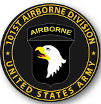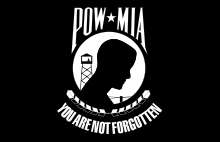

The reorganization from battle groups to brigades and battalions placed two battalions of the 502nd in different brigades of the 101st. The 2nd Battalion, 502nd Infantry Regiment was in the 1st Brigade with the 1st Battalion, 327th Infantry Regiment and 2nd Battalion, 327th Infantry Regiment and deployed to Vietnam and arrived at Cam Ranh Bay, Vietnam on 29 July 1965, they were commanded by the most notable commander LTC Hank "The Gunfighter" Emerson.
The new 2nd Brigade's original organic battalions were the 1st Battalion, 501st Infantry Regiment, 2nd Battalion, 501st Infantry Regiment and the 1st Battalion, 502nd Infantry Regiment. In December 1967, the 1-501st, 2-501st, 1-502nd and 2nd Brigade deployed by C-141 aircraft and arrived at Bien Hoa Airbase on 13 December 1967. Over the next five years. Soldiers of the "Ready to Go" Brigade participated in twelve campaigns, compiling of a distinguished combat record as well as an enviable reputation for success in the rehabilitation of a war-torn nation. The Brigade redeployed to Fort Campbell in April 1972.
During the Vietnam War the 101st went through many reorganized and redesignated as an Airmobile Division in mid-1968 and then in 1974 as an Air Assault Division.

The "BLACK HEART" is the symbol distinctive to the 502nd Infantry Regiment and dates to when the 502nd painted the Heart on their helmets (painted in white back then) to aid in identification following the combat jump into Normandy.

The 501st Infantry Regiment Coat of Arms, on the shield it shows the Argent an Ojibway (Chippewa) thunderbird Azure garnished Gules. On the wreath Argent and Azure a lion Or langued and armed Gules charged on the shoulder with an escutcheon per pale of the like and of the second and holding in his right paw a staff bend sinisterwise of the third flying a standard per fess of the second and of the third, and in his left paw a key bendwise of the last. The shield colors blue and white indicate the Infantry nature of the organization. The thunderbird is an appropriate symbol for a parachute battalion. The motto "GERONIMO" has its origin in a cry uttered in the maiden jump of the test platoon and is now a tradition with the 501st Parachute Battalion. The crest colors blue and yellow stand for the official standard of the town of Veghel, Holland. It was presented by the town to the old 501st in honor of their efforts in liberating the village from the enemy. The lion refers to a Citation in the Order of the Day of the Belgian Army for the action at Bastogne, whose arms are suggested by the red and blue shield on the lion's shoulder. The key refers to the position of Bastogne as a focal point of the German counterattack.

The 502nd Infantry Regiment Coat of Arms, placed in the center, shows the blue shield with grasping eagle claw that represents the regiment's lineage as an Airborne Regiment in World War II, as well as the unit's ability to STRIKE the enemy from above. The bayonets have dual meaning and represent LTC Robert G. Cole (Battalion Commander of 3-502) who led a bayonet charge during the fight to secure the causeway outside Carentan, France. LTC Cole was the 101st Division's first Medal of Honor recipient in WW II. The crossed M1 Garand Bayonets also symbolize our Regiment's two Presidential Unit Citations and the two assault landings in World War II at Normandy and Holland. The orange eagle's feather stands for the unit's airborne function; orange, the national color of the Netherlands, refers to the liberation of Best, Holland. The white four-bastioned fort encircled by a black background represents Bastogne, Belgium, and symbolizes the 502nd's participation in the Battle of the Bulge. The ermine spot on the white fort refers to the snow which blanketed the Battle of the Bulge's terrain
 |
 |
 |